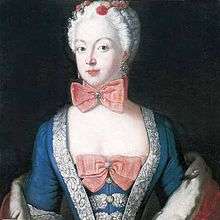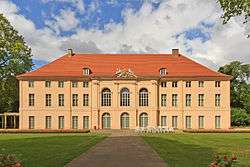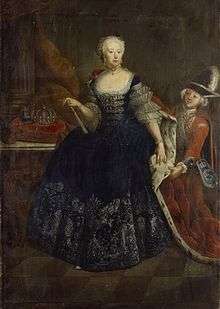Elisabeth Christine of Brunswick-Wolfenbüttel-Bevern
| Elisabeth Christine | |
|---|---|
.jpg) Queen Elisabeth Christine in c. 1740 by Antoine Pesne | |
| Queen consort of Prussia Electress consort of Brandenburg | |
| Tenure | 31 May 1740 – 17 August 1786 |
| Born |
8 November 1715 Schloss Bevern, Germany |
| Died |
13 January 1797 (aged 81) Stadtschloss, Berlin, Prussia |
| Burial | Berlin Cathedral |
| Spouse | Frederick II of Prussia |
| House | Brunswick-Bevern |
| Father | Ferdinand Albert II, Duke of Brunswick-Wolfenbüttel |
| Mother | Antoinette of Brunswick-Wolfenbüttel |
| Religion | Lutheranism |
Elisabeth Christine of Brunswick-Wolfenbüttel-Bevern (8 November 1715 – 13 January 1797) was Queen of Prussia from 1740 to 1786 as the spouse of Frederick the Great. By birth, she was a Duchess of Brunswick-Wolfenbüttel. She was also the longest serving queen of Prussia.
Background
Elisabeth Christine was born the daughter of Duke Ferdinand Albert II and Duchess Antoinette of Brunswick-Wolfenbüttel.
In 1733, Crown Prince Frederick of Prussia, having failed in his attempt to flee from his father's tyrannical regime, was ordered to marry a daughter of the Duke of Brunswick-Lüneburg.[1] Elisabeth Christine was the niece of Holy Roman Emperor Charles VI's wife Elisabeth Christine of Brunswick-Wolfenbüttel; the match had thus been arranged by the Austrian court in the hopes of securing influence over Prussia for another generation.[1]


Crown Princess
On 12 June 1733, Elisabeth-Christine married Frederick at her father's summer palace, Schloss Salzdahlum in Wolfenbüttel, Germany. On their wedding night, Frederick spent a reluctant hour with his new wife and then walked about outside for the rest of the night. Due to the circumstances behind their betrothal, Frederick was well known to have resented the marriage from the very beginning.[1] He had only agreed to marry Elisabeth after his failed attempt to escape from his father's tyrannical regime. The King had thereafter ordered Frederick to marry the daughter of Duke Ferdinand Albrecht of Brunswick-Wolfenbuttel, and Frederick had submitted to his father's will in order to regain his freedom.
Thus, the position of Elisabeth-Christine, who was only seventeen on her marriage, at the Berlin Court, was difficult from the beginning, as the only support that she could count on was the King's. Her father-in-law, Frederick William I, had indeed remained attached to his daughter-in-law until his death and was particularly fond of her piety, which did nothing to endear her husband. However, Frederick was shrewd enough to recognise the opportunity his wife provided to improve his own relationship with his father, and systematically used her to gain favours from him. During the first year of their marriage, Frederick was garrisoned in Ruppin, while Elisabeth lived in Berlin at the King's Court, and he showered her with letters asking for travel permits, money, etc. from the King or even demanding that she run up debts in Brunswick to pay for his expenses. This pattern continued even after the couple moved to the palace in Rheinsberg in 1736.
There, Frederick was allowed to maintain a court of his own for the first time, and there the couple's marital life seems to have been as normal as it would ever become; Elisabeth-Christine later recalled the Rheinsberg years as the "happiest of her life". However, the basis for this relationship, which was characterised by honest admiration, or even love, on Elisabeth's side, and cool calculation on Frederick's, disappeared with his accession to the throne in 1740.
Queen

In 1740, Frederick's father died and he succeeded to the throne of Prussia as Frederick II. He then initiated the separation between the two. Elisabeth Christine began living separately from him, taking up her residence at Schönhausen Palace, nowadays in the north of Berlin, while Frederick resided in Potsdam. It should be mentioned that throughout his life, Frederick did not show any sexual interest in women, and the only woman whom he considered a close friend was his older sister, Wilhelmine. He had no known affairs and presided over a very spartan, almost military court, where women rarely appeared and never held any influence. Tradition has it that Elisabeth Christine could not understand Frederick's indifference and that she had an unrequited love for her spouse. Her mother-in-law felt sorry for her because of this and often invited her to her residence.
Frederick the Great did not care for ceremonial court life and representation, which he associated with the undue influence of females upon state affairs, such as the influence of the royal mistresses in France, and left most of the posts in his own court vacant and thereby did not possess much of a court at Potsdam.[2] During the first years of his reign, he did somewhat revive the court life, but after his palace of Sanssouci in Potsdam was completed in 1747, he spent his life more and more isolated in Sanssouci in the summer and the Potsdam royal residence in winter, and only appeared at the official royal court in Berlin at special occasions such as birthdays of members of the royal house and visits of foreign princes.
Despite his personal contempt for representational court life, however, he realized its importance in the system of state, and therefore did not abolish court life in Prussia, but rather left virtually all representational duties to his wife.[3] Queen Elisabeth Christine therefore had a very visible and official role as queen of Prussia: during the first seventeen years of his reign, she shared the representational duties of the court with her mother-in-law, and after the death of the dowager queen in 1757, she handled them alone. When he became king, Frederick gave Elisabeth Christine her own summer palace Schönhausen Palace outside Berlin as a summer residence, redecorated the state apartments in the Berlin Royal Palace, and appointed a large court for her to assist her in relieving him of upholding the court routine. Elisabeth Christine spent her winters in the Royal Palace in Berlin, where she received foreign princes, ambassadors and generals and hosted official court events such as royal birthdays and weddings, and she spent her summers at Schönhausen, where she entertained the royal family and the Prussian aristocracy with concerts and dinners in a circle of Lutheran theologians such as Büschning, Spaldning and Zöllner.[4] At both residences, she presided at the weekly reception days, courtage, which were the only occasions were the entire Prussian royal court assembled as a whole during the reign of Frederick the Great.[5]
The king himself only very rarely attended any of the court events, while the queen was always present. He visited the birthday celebration of the queen only twice between 1741 and 1762, was often absent at royal weddings, such as for example the wedding of Prince Henry in 1752 and Prince Frederick William in 1765, where she also acted as his representative: he was often absent even at his own official birthday celebration, where she normally received birthday congratulations in his place, and when he did attend, he normally only appeared very swiftly and then left again.[6] When he did appear in Berlin, he normally did not represent at his own apartment, but merely visited the queen's reception in her apartment.[7] Frederick was often absent even at important functions, such as the state visit of the Russian Grand Duke in 1776. While he on rare occasions participated in Berlin court life, he never visited her court at Schönhausen, nor was she ever invited to Sanssouci. Though Elisabeth Christine was never involved in any politics and lacked any influence whatsoever, her receptions were always well attended as she hosted the only court life taking place in Prussia at the time, which made it an important social center and a place to meet important people.[8]
During the Seven Years' War, the king was permanently absent from the capital for six years. He had left the queen no formal responsibility or instructions, but she became the symbol of Prussian resilience in the capital during the crisis, and was greeted by cheering crowds when she appeared in public.[9] When Berlin was threatened in 1757, it was she who took the responsibility for the royal house and court, and ordered for it to be evacuated to Magdeburg.[10] She was able to return to Berlin in 1758, but was again forced to evacuate in 1760. It was on the first of these occasions that she saw Sanssouci for the first time. In 1763, when Frederick saw his wife for the first time in six years, he only commented: "Madame has grown quite fat." Despite his lack of interest in her person, Frederick demanded that Elisabeth Christine be respected in her capacity as a queen and her task in upholding the representational court life he avoided, but his separation from her and her subsequent lack of influence, in combination with her timid personality, aroused pity and made it hard for her to receive respect: on one occasion, for example, the opera singers refused to appear at her concert, and she was forced to ask Fredrick to demand that she be treated with respect.[11]
Elisabeth Christine was interested in literature, and she herself also wrote books in French about religious themes. She introduced silk cultivation to Prussia, and she was involved in charity, for which she contributed 23.000 talers out of an allowance of 40.000 talers. She said of herself: "God has graciously kept me, so that I need not reproach myself for any action by which any person has with my knowledge been hurt."[12]
Ancestors
References
- 1 2 3 Biskup, p. 304.
- ↑ Clarissa Campbell Orr: Queenship in Europe 1660-1815: The Role of the Consort. Cambridge University Press (2004)
- ↑ Clarissa Campbell Orr: Queenship in Europe 1660-1815: The Role of the Consort. Cambridge University Press (2004)
- ↑ Clarissa Campbell Orr: Queenship in Europe 1660-1815: The Role of the Consort. Cambridge University Press (2004)
- ↑ Clarissa Campbell Orr: Queenship in Europe 1660-1815: The Role of the Consort. Cambridge University Press (2004)
- ↑ Clarissa Campbell Orr: Queenship in Europe 1660-1815: The Role of the Consort. Cambridge University Press (2004)
- ↑ Clarissa Campbell Orr: Queenship in Europe 1660-1815: The Role of the Consort. Cambridge University Press (2004)
- ↑ Clarissa Campbell Orr: Queenship in Europe 1660-1815: The Role of the Consort. Cambridge University Press (2004)
- ↑ Clarissa Campbell Orr: Queenship in Europe 1660-1815: The Role of the Consort. Cambridge University Press (2004)
- ↑ Clarissa Campbell Orr: Queenship in Europe 1660-1815: The Role of the Consort. Cambridge University Press (2004)
- ↑ Clarissa Campbell Orr: Queenship in Europe 1660-1815: The Role of the Consort. Cambridge University Press (2004)
- ↑ Reiners, Ludwig (Swedish): Fredrik den store (Fredrick the Great). Bokindustri Aktiebolag (1956) Stockholm
Sources
- Biskup, Thomas. (2004). "The Hidden Queen: Elisabeth Christine of Prussia and Hohenzollern Queenship in the Eighteenth Century" in Queenship in Europe 1660-1815: The Role of the Consort. Clarissa Campbell Orr (ed.). Cambridge University Press. ISBN 0-521-81422-7.
- Hans-Henning Grote (2005) Schloss Wolfenbüttel. Residenz der Herzöge zu Braunschweig und Lüneburg. S. 228. ISBN 3-937664-32-7.
- Paul Noack: Elisabeth Christine und Friedrich der Große. Ein Frauenleben in Preußen. 2. Auflage. Klett-Cotta, Stuttgart 2002, S. 185, ISBN 3-608-94292-0
- Reiners, Ludwig (Swedish): Fredrik den store (Fredrick the Great). Bokindustri Aktiebolag (1956) Stockholm
External links
| Wikimedia Commons has media related to Elisabeth Christine von Braunschweig-Bevern. |
| Elisabeth Christine of Brunswick-Wolfenbüttel-Bevern Born: 8 November 1715 Died: 13 January 1797 | ||
| German royalty | ||
|---|---|---|
| Preceded by Sophia Dorothea of Hanover |
Queen consort in Prussia 31 May 1740 – 19 February 1772 |
Title abolished elevated to Queen consort of Prussia |
| New title | Queen consort of Prussia 19 February 1772 - 17 August 1786 |
Succeeded by Frederika Louisa of Hesse-Darmstadt |